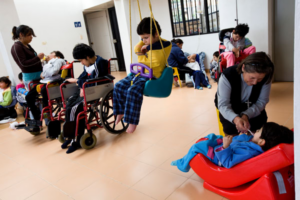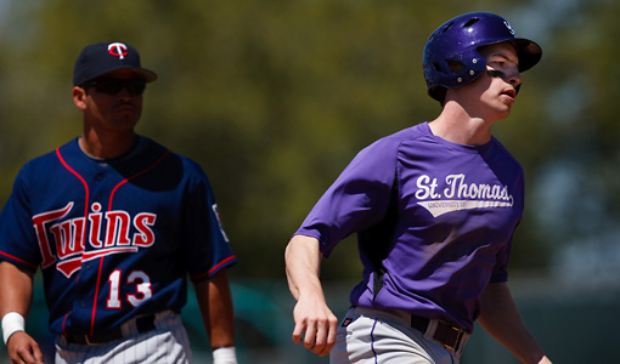$100,000 Finalist
BOGOTÁ, COLOMBIA – Sister Valeriana García-Martín hears the greetings the moment she enters the lunchroom at her school: “Hermana, Hermana!” the children exclaim.
She exchanges smiles and hugs and kisses as the children descend upon her, excited that she has dropped by for a visit. She revels in their attention, and they in hers, all content in the love they share. Not just any kind of love … God’s love.
“The life I wish for these children is one of quality, because they deserve that,” García-Martín said. “All we do is done with quality, with love. If we are able to come near and give them a hug, then we must do it with love. If we are going to give them food, we give it with love. If we are going to clean their little faces, we do it with love. …
“They have much more to give us than what we give them. Much more.”
It was love that motivated García-Martín to leave a secure position at the National Institute for Blind Children in Bogotá in 1991 to open a home for four blind girls who had been abandoned or given up by their parents.
It was love that propelled her through those difficult early years. She kept taking in more children, determined to provide them with shelter, food, clothing, medical care and – just as importantly in her view – dignity.
And it was love that made Hogares Luz y Vida – Homes of Light and Life – a beacon that today serves more than 1,000 children, with and without physical and mental disabilities, at eight sites in the Bogotá area.
García-Martín, 68, grew up near Sevilla, Spain, the sixth oldest of 14 children. She joined the Filipense order when she was 17 and moved to Colombia in 1970, working as a nurse in several communities before taking a position at the blind institute in 1984.
She became particularly attached to one blind infant that year, named her Valeriana and began to envision a home where she could care for children who had other disabilities. Her siblings had given her money for a car, but she used it to buy a small house and open Luz y Vida, where she had an early – and candid – discussion with God.
“I said to him, ‘Lord, here I am. Thank you for choosing me. You know the fear I have. You are going to be in charge of feeding the children. I will work on the other things.’
“The Lord has accomplished this, because I have never lacked food for the children.”
García-Martín adopted her namesake in 1994 and a second girl, Rosita, two years later. Valeriana is now 25 and is studying in Spain. Rosita, who cannot speak and is wheelchair-bound, is 18 and attends the primary school that her mother runs.
Rosita’s plight is similar to many of the children who arrive at Luz y Vida. The police brought in the six-week-old daughter of a drug addict at midnight after she was found abandoned on the back seat of a bus – her tiny body diseased, beaten and scarred with cigarette burns.
One by one, García-Martín took in children like Rosita and earned a reputation as someone “who doesn’t have any limits,” said German Arturo Cabrera, a government welfare official. “She’ll work with any kids. She just goes and goes and goes.”
She shrugs when asked to take in more children: “The beds,” she said, “will need to be closer.”
García-Martín knew early at Luz y Vida that she would need to be more than a health-care provider. She opened a school for 15 children, then found land and benefactors for a new school in 2007. More than 100 children are enrolled in eight grades, and a day care center on the site serves 275.
Some of the children have disabilities but many do not – all part of her goal to integrate children of all backgrounds. “We educate them to see themselves as equal – to see themselves as brothers and sisters,” she said. “The younger they are, the more we are able to do this.”
As important as the school is, the nerve center for Luz y Vida remains Casa San Jose, the original house that García-Martín purchased and has expanded eight times. Today it is home for 100 children who have a wide range of disabilities. Some scamper up and down long ramps, and others are restricted to chairs and must be spoon-fed or receive nourishment through feeding tubes.
Luz y Vida has a staff of 60, including Assistant Director Ana Belen Londono and her husband, Reinerio Cuervo Lopez. Their boss’ vision and resolve amazes – but does not surprise – them.
“She imagines things so big that you ask yourself, ‘How can she visualize that? How will she achieve it?’” Londono said. “When she started, people called her a crazy nun because she wanted to make these buildings. But when everything she says becomes reality, you say, ‘Her faith is so big that God put her next to us to teach us.’ Maybe the biggest lesson is this: How to live your faith and believe you can do things.”
García-Martín believes she can do more and has a list of projects. She wants to add a medical clinic at Casa San Jose so children don’t have to be transported as often to hospitals, and she hopes to open a high school. She laughs as she recalls how a psychologist once asked her, “Hermana, how much are you going to do? Where is the end?”
"Wherever there is a need, we will respond."
“I said, ‘I don’t know. Wherever there is a need, we will respond.’
“God spoils me. He knows that when I want to do something, it is for the well-being of the children. And then things start happening.”
Eighteen-year-old Lady Bermudez and two younger sisters have seen García-Martín respond for a decade. Their mom left them at Casa San Jose one evening and they stayed – and thrived.
“Sister has been like our mother,” said Bermudez, who is studying to be a nurse’s assistant and hopes one day to work at Luz y Vida. “She has taught us a lot about life. She has taught us to value, respect and love ourselves. She also has taught us that we are all the same – we are limited on the inside, just like some of the children are limited on the outside.”
As Bermudez sits outside on a bright Saturday morning in August, García-Martín plays with children and rides a scooter. She later walks to a nearby hillside where kids from Luz y Vida and the neighborhood are flying kites together. She picks up a kite string and tugs on it but it barely rises, and she laughs at her futility.
As it turns out, a kite is part of the Luz y Vida logo. A family flies a kite, and its flight symbolizes freedom. The green in the logo stands for hope, the white for light and the red for love.
Love … It’s always about love with García-Martín.
“In the beginning, and even today, many people didn’t believe in us,” she said. “But we believe in what we are doing, and we believe in the children because we believe in love.
“With love, we can do everything.”About the Opus Prize: St. Thomas and the Opus Prize Foundation of Minnetonka, Minn., collaborated to identify the honorees, recognized as unsung heroes who are transforming lives through a commitment to service and social entrepreneurship. They will use the award money from the foundation to further their faithbased humanitarian efforts. Find out more at www.stthomas.edu/opusprize




